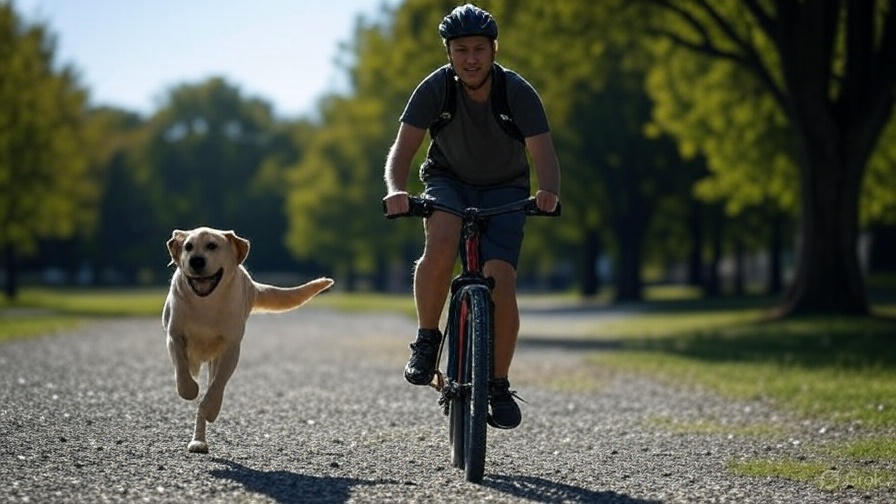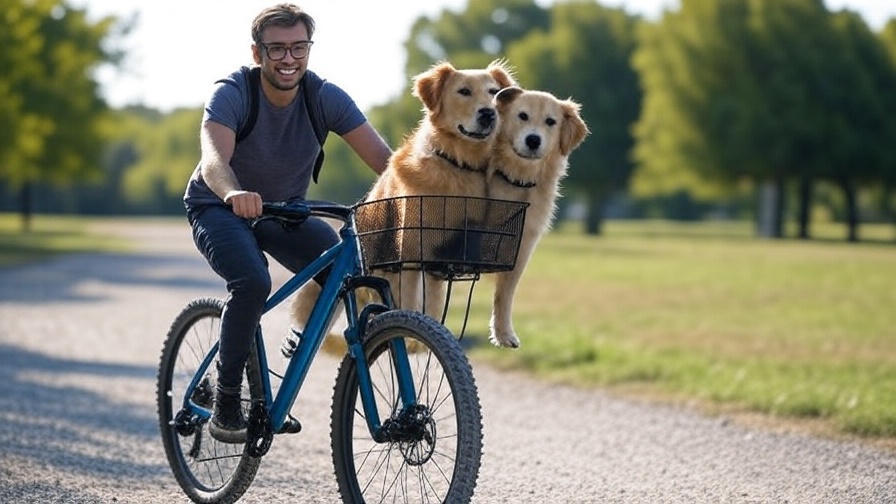How to Bike Ride with a Dog?
Biking with your furry companion opens up a world of exciting outdoor adventures. Many dog owners discover that cycling alongside their pets creates stronger bonds while providing excellent exercise for both. This comprehensive guide walks you through everything you need to know about biking safely with your dog.
Getting Started: Is Your Dog Ready for Bike Rides?
Before you hit the trails, evaluate your dog’s fitness level and temperament. Dogs need proper conditioning just like humans do. Start by assessing your pet’s age, health, and energy levels.
Puppies under 18 months shouldn’t participate in long bike rides because their joints and bones are still developing. Senior dogs may struggle with extended exercise sessions, so consult your veterinarian first. Medium to large breeds typically handle bike riding better than small dogs, though exceptions exist.
Your dog’s personality matters too. Calm, well-trained dogs adapt to biking faster than hyperactive or anxious pets. Dogs that pull excessively on walks will likely struggle with bike training initially.
Essential Equipment for Dog Biking Adventures
Safety equipment protects both you and your dog during rides. Start with a proper dog harness designed for running or biking activities. Regular collars can injure your dog’s neck if sudden stops occur.
Bike attachments keep your hands free while maintaining control. Springer attachments connect to your bike frame and provide shock absorption. Walky Dog attachments offer similar benefits with different mounting options. Both systems prevent your dog from getting too close to the wheels or wandering into traffic.
Consider protective gear for your dog’s paws. Booties shield sensitive paw pads from hot pavement, rough terrain, and sharp objects. Not all dogs accept booties immediately, so introduce them gradually during training.
A well-fitted bike helmet protects you from potential falls. Reflective gear increases visibility during early morning or evening rides. Pack water bottles for both you and your dog, especially during warm weather.
Training Your Dog for Bike Rides
Start training on foot before introducing the bicycle. Practice basic commands like “heel,” “stay,” and “slow” during regular walks. Your dog should respond consistently to these commands before bike training begins.
Introduce your bike gradually. Let your dog sniff and investigate the bicycle while it’s stationary. Reward calm behavior with treats and praise. Some dogs fear the bike initially, so patience helps build confidence.
Walk beside your bike while your dog walks on the opposite side. This positioning prevents your dog from getting tangled in the wheels. Practice stopping, starting, and turning while maintaining this formation.
Begin short riding sessions once your dog walks calmly beside the moving bike. Start with 5-10 minute rides at slow speeds. Gradually increase duration and pace as your dog’s fitness improves. Watch for signs of fatigue like excessive panting, lagging behind, or stopping frequently.
Safety First: Protecting Your Dog During Rides
Temperature awareness prevents overheating and paw injuries. Hot pavement can burn your dog’s paw pads within minutes. Test pavement temperature with your hand – if it’s too hot for you, it’s too hot for your dog. Schedule rides during cooler parts of the day.
Hydration becomes critical during longer rides. Dogs cool themselves primarily through panting, which increases water loss. Stop every 15-20 minutes to offer water, especially on warm days. Portable dog water bottles make hydration convenient.
Monitor your dog’s energy levels throughout the ride. Signs of exhaustion include excessive drooling, stumbling, or refusing to continue. Stop immediately if these symptoms appear. Dogs often push themselves beyond safe limits to please their owners.
Traffic poses significant dangers for biking dogs. Stick to bike paths, quiet residential streets, or designated trails whenever possible. Urban environments present too many distractions and hazards for most dogs.
Route Planning and Terrain Considerations
Choose appropriate routes based on your dog’s abilities and experience level. Flat, paved paths work best for beginners. Avoid steep hills until your dog builds stamina and strength.
Surface types affect your dog’s comfort and safety. Smooth asphalt provides good traction but heats up quickly. Dirt trails offer cooler surfaces but may contain hazards like thorns or glass. Concrete sidewalks often have uneven sections that could trip your dog.
Distance planning prevents overexertion. Start with 1-2 mile routes and gradually increase mileage. Most dogs can eventually handle 5-10 mile rides with proper conditioning. Larger, athletic breeds may cover even greater distances.
Check trail conditions before departing. Wet surfaces become slippery, and muddy paths can hide dangers. Construction zones often contain sharp debris that could injure paws.
Building Your Dog’s Endurance Safely
Gradual conditioning prevents injuries and builds lasting fitness. Increase ride duration by 10-15% each week. This conservative approach allows your dog’s muscles, joints, and cardiovascular system to adapt properly.
Cross-training improves overall fitness while reducing repetitive stress. Swimming, hiking, and fetch games develop different muscle groups. These activities also provide mental stimulation that purely repetitive exercise lacks.
Rest days allow recovery and prevent burnout. Active dogs often resist taking breaks, but forced rest prevents overuse injuries. Plan at least one full rest day per week during intensive training periods.
Nutrition supports your dog’s increased activity levels. High-quality protein helps repair and build muscle tissue. Complex carbohydrates provide sustained energy for longer rides. Consult your veterinarian about adjusting your dog’s diet for increased exercise.

Common Mistakes Dog Owners Make
Rushing the training process leads to problems later. Dogs need time to develop the skills and fitness required for safe biking. Skipping foundational training often results in behavioral issues or injuries.
Ignoring weather conditions puts dogs at risk. Many owners underestimate how quickly dogs overheat during exercise. Heat stroke can occur within minutes under the right conditions.
Using inappropriate equipment creates safety hazards. Regular leashes can wrap around bike wheels or throw riders off balance. Retractable leashes provide no control in emergency situations.
Failing to read dog body language results in pushed-beyond-limits pets. Dogs rarely quit voluntarily, so owners must recognize fatigue signs and make stopping decisions.
Different Biking Styles for Different Dogs
Road biking suits dogs that enjoy steady, consistent exercise. This style works well for medium to large breeds with good endurance. Maintain moderate speeds to prevent overexertion.
Mountain biking requires careful consideration. Rough terrain challenges dogs physically and mentally. Only attempt this with highly trained, athletic dogs. Start with easy trails and progress gradually.
Recreational biking offers the most flexibility. Stop frequently for exploration, water breaks, and rest. This relaxed approach suits most dogs and owners who prioritize fun over fitness goals.
Bikejoring involves dogs pulling or assisting the bike’s forward motion. This activity requires specialized equipment and training. Nordic breeds often excel at bikejoring due to their sled dog heritage.
Seasonal Considerations for Dog Biking
Summer riding demands extra precautions. Early morning or late evening rides avoid peak heat. Always carry extra water and know signs of heat exhaustion. Light-colored dogs may need sunscreen on exposed skin areas.
Winter conditions present unique challenges. Ice makes surfaces dangerous for both bike tires and dog paws. Cold air can irritate respiratory systems during intense exercise. Consider protective clothing for short-haired breeds.
Spring weather offers ideal biking conditions but watch for seasonal hazards. Melting snow creates muddy, slippery conditions. Increased wildlife activity may distract or frighten dogs.
Fall provides comfortable temperatures but brings new considerations. Fallen leaves hide potential hazards like holes or debris. Shorter daylight hours require earlier ride planning.
Health Benefits for Dogs and Owners
Regular biking provides excellent cardiovascular exercise for dogs. This activity strengthens heart muscles and improves circulation. Well-conditioned dogs show increased energy and better mood overall.
Joint health improves through regular, low-impact exercise. Biking puts less stress on joints compared to running on hard surfaces. This benefit particularly helps older dogs maintain mobility.
Mental stimulation accompanies physical exercise during bike rides. New sights, sounds, and smells engage your dog’s senses. This environmental enrichment reduces destructive behaviors caused by boredom.
Weight management becomes easier with regular biking sessions. Obesity affects many pet dogs and contributes to various health problems. Consistent exercise helps maintain healthy body weight.
Owners benefit from improved fitness and stress reduction. Cycling provides excellent low-impact exercise while spending quality time with pets. This dual benefit motivates many people to maintain regular exercise routines.
Troubleshooting Common Problems
Dogs that pull excessively need additional leash training before biking. Practice loose-leash walking until your dog maintains proper position consistently. Use positive reinforcement techniques rather than punishment-based methods.
Fearful dogs require patient, gradual exposure to biking equipment and situations. Some dogs need weeks or months to build confidence. Never force a frightened dog into biking activities.
Easily distracted dogs benefit from focused training sessions. Practice commands in various environments with increasing distraction levels. Start in quiet areas and gradually introduce more stimulating environments.
Dogs that tire quickly may have underlying health issues. Sudden changes in stamina warrant veterinary examination. Some dogs need longer conditioning periods to build adequate fitness.
Making Biking Fun for Your Dog
Positive associations help dogs enjoy biking adventures. Always end rides on a positive note with praise and treats. Keep early sessions short and successful rather than long and exhausting.
Variety prevents boredom during regular biking routines. Explore different routes, surfaces, and environments. Dogs appreciate new experiences and mental challenges.
Social aspects enhance the biking experience. Dogs often enjoy meeting other dogs and people during rides. Plan stops at dog-friendly locations for socialization opportunities.
Reward good behavior immediately during rides. Carry high-value treats for reinforcing proper positioning and responses to commands. Consistent positive reinforcement builds reliable behaviors.
Long-term Success Strategies
Regular veterinary checkups monitor your dog’s health during increased activity levels. Some conditions only become apparent during intensive exercise programs. Early detection prevents minor issues from becoming serious problems.
Equipment maintenance ensures continued safety. Check bike attachments regularly for wear or damage. Replace worn items before they fail during rides.
Flexibility adapts to changing circumstances. Your dog’s needs may change due to age, health, or seasonal factors. Successful biking partnerships adjust expectations and activities accordingly.
Community involvement provides ongoing motivation and support. Local biking groups often welcome dogs and offer valuable advice. Online communities share experiences and troubleshooting tips.
Conclusion
Biking with your dog creates wonderful opportunities for exercise, bonding, and adventure. Success requires patience, proper equipment, and gradual training. Start slowly, prioritize safety, and maintain realistic expectations based on your dog’s abilities.
Remember that not every dog will enjoy or succeed at biking. Respect your pet’s limitations and preferences. With proper preparation and training, many dogs and owners discover that biking together becomes a favorite shared activity that enhances their relationship while promoting health and fitness for both.







